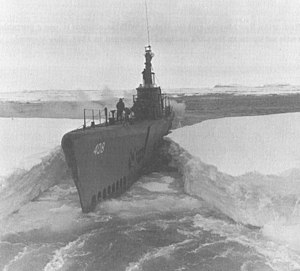This article needs additional citations for verification. (January 2018) |
 Sennet (SS-408) in the Antarctic Ocean during Operation Highjump, 1946
| |
| History | |
|---|---|
| Builder | Portsmouth Naval Shipyard, Kittery, Maine[1] |
| Laid down | 8 March 1944[1] |
| Launched | 6 June 1944[1] |
| Commissioned | 22 August 1944[1] |
| Decommissioned | 2 December 1968[1] |
| Stricken | 2 December 1968[1] |
| Fate | Sold for scrap, 15 June 1973[1] |
| General characteristics | |
| Class and type | Balao class diesel-electric submarine[2] |
| Displacement | |
| Length | 311 ft 8 in (95.00 m)[2] |
| Beam | 27 ft 3 in (8.31 m)[2] |
| Draft | 16 ft 10 in (5.13 m) maximum[2] |
| Propulsion |
|
| Speed | |
| Range | 11,000 nautical miles (20,000 km) surfaced at 10 knots (19 km/h)[6] |
| Endurance |
|
| Test depth | 400 ft (120 m)[6] |
| Complement | 10 officers, 70–71 enlisted[6] |
| Armament |
|
USS Sennet (SS-408) was a Balao-class submarine, a ship of the United States Navy named for the sennet, a barracuda.
Sennet was laid down on 8 March 1944 by the Portsmouth Navy Yard in Kittery, Maine, launched on 6 June 1944, sponsored by Mrs. Roscoe W. Downs, and commissioned on 22 August 1944.
Sennet was fitted out by 18 September. She held training exercises and torpedo-tube testing off the coast of Connecticut and Rhode Island until 22 October. The submarine then tested mines and torpedoes for the Mine Warfare Test Station, Solomons Island, Md. On 11 November, Sennet proceeded to the operations area off Balboa, C. Z. and conducted further training exercises. The submarine departed Balboa on 29 November for Pearl Harbor and arrived there on 16 December 1944.
Sennet's topside armament was increased to two 5-inch (130 mm) guns, two 40 millimeter guns, and three .50 caliber machine guns before departing Pearl Harbor for her first war patrol on 5 January 1945.
- ^ a b c d e f g Friedman, Norman (1995). U.S. Submarines Through 1945: An Illustrated Design History. Annapolis, Maryland: United States Naval Institute. pp. 285–304. ISBN 1-55750-263-3.
- ^ a b c d e f Bauer, K. Jack; Roberts, Stephen S. (1991). Register of Ships of the U.S. Navy, 1775–1990: Major Combatants. Westport, Connecticut: Greenwood Press. pp. 275–280. ISBN 0-313-26202-0.
- ^ a b c d e Bauer, K. Jack; Roberts, Stephen S. (1991). Register of Ships of the U.S. Navy, 1775–1990: Major Combatants. Westport, Connecticut: Greenwood Press. pp. 275–282. ISBN 978-0-313-26202-9.
- ^ U.S. Submarines Through 1945 pp. 261–263
- ^ a b c U.S. Submarines Through 1945 pp. 305–311
- ^ a b c d e f U.S. Submarines Through 1945 pp. 305–311